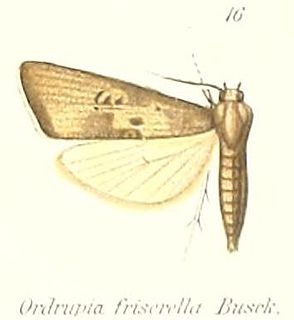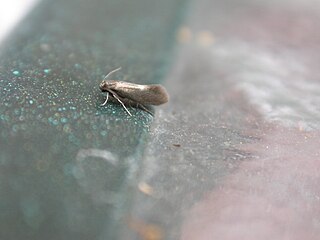Heterobathmia is a genus of Lepidoptera. It is the only genus in the suborder Heterobathmiina, as well as in the superfamily Heterobathmioidea and in the family Heterobathmiidae. Primitive, day-flying, metallic moths confined to southern South America, the adults eat the pollen of Nothofagus or southern beech and the larvae mine the leaves. Most known species are undescribed.
Simaethistoidea is an obscure superfamily of pyralid-like moths with two genera, whose biology and relationships among the Ditrysia is currently unknown, namely the Australian Metaprotus and the China and North Indian Simaethistis.
Neopseustidae is a small family of day and night-flying "archaic bell moths" in the order Lepidoptera. They are classified into their own superfamily Neopseustoidea and infraorder Neopseustina. Four genera are known. These primitive moths are restricted to South America and South east Asia and their biology is unknown. Nematocentropus appears to be the most primitive genus occurring in Assam, Myanmar and Sichuan, China, three species of Neopseustis are distributed from Assam to Taiwan, whilst Synempora andesae and three species of Apoplania occur in southern South America. The morphology of the antennae and the proboscis has been studied in detail.

Immoidea is a superfamily of pantropical moths containing only the family Immidae comprising ten genera with around 250 species, over half of them in the genus Imma. Many are brightly coloured and diurnal. The position of this group is currently uncertain within the group Obtectomera. The larvae feed on the leaves of dicotyledons and conifers including Podocarpus.

Lophocoronoidea is a superfamily of insects in the order Lepidoptera. There is a single genus, Lophocorona, in the family Lophocoronidae. These are small, primitive nocturnal moths restricted to Australia whose biology is largely unknown.

Nepticulidae is a family of very small moths with a worldwide distribution. They are characterised by eyecaps over the eyes. These pigmy moths or midget moths, as they are commonly known, include the smallest of all living moths, with a wingspan that can be as little as 3 mm in the case of the European pigmy sorrel moth, but more usually 3.5–10 mm. The wings of adult moths are narrow and lanceolate, sometimes with metallic markings, and with the venation very simplified compared to most other moths.

Carposinidae, the "fruitworm moths", is a family of insects in the order Lepidoptera. These moths are narrower winged than Copromorphidae, with less rounded forewing tips. Males often have conspicuous patches of scales on either surface. The mouthparts are quite diagnostic, usually with prominent, upcurved "labial palps", the third segment long, and the second segment covered in large scales. Unlike Copromorphidae, the "M2" and sometimes "M1" vein on the hindwings is absent. The relationship of Carposinidae relative to Copromorphidae needs further investigation. It is considered possible that the family is artificial, being nested within Copromorphidae. The Palearctic species have been revised by Alexey Diakonoff (1989).

Choreutidae, or metalmark moths, are a family of insects in the lepidopteran order whose relationships have been long disputed. It was placed previously in the superfamily Yponomeutoidea in family Glyphipterigidae and in superfamily Sesioidea. It is now considered to represent its own superfamily. The relationship of the family to the other lineages in the group "Apoditrysia" need a new assessment, especially with new molecular data.

Copromorphidae, the "tropical fruitworm moths" is a family of insects in the lepidopteran order. These moths have broad, rounded forewings, and well-camouflaged scale patterns. Unlike Carposinidae the mouthparts include "labial palps" with the second rather than third segment the longest. With other unusual structural characteristics of the caterpillar and adult, it could represent the sister lineage of all other extant members of this superfamily. The genus Sisyroxena from Madagascar is also notable for its unusual venation and wing scale sockets.

Galacticidae is a recently recognised and enigmatic family of insects in the lepidopteran order. These moderate sized moths are 8–17 mm in wingspan and have previously been embedded within several lepidopteran superfamilies, but Galacticidae is currently placed in its own superfamily at the base of the natural group Apoditrysia.

Epermeniidae or the fringe-tufted moths is a family of insects in the lepidopteran order with about 14 genera. Previously they have been divided in two subfamilies Epermeniinae and Ochromolopinae but this is no longer maintained since the last group is probably hierarchically nested within the first. They are presently placed in their own superfamily but have previously been placed among the Yponomeutoidea or Copromorphoidea with which they share some features. Their systematic placement among the apoditrysian group "Obtectomera" is however uncertain. They show some morphological similarities to the "plume moths", for example the wing fringe has similar groups of scales. There are also some similarities to Schreckensteinioidea, for example spiny legs and at least in some species an open-network cocoon. The genus Thambotricha from New Zealand may be the sister group of all other extant members. The most important genera are Epermenia, Ochromolopis and Gnathifera. The group has been extensively revised and catalogued by Dr Reinhard Gaedike.
Whalleyana is an enigmatic genus of moths in the lepidopteran group Obtectomera, endemic to Madagascar. The genus contains two species, whose biology and closest relatives are unknown. The genus had been placed in the picture-winged leaf moths, (Thyrididae), but then was placed in its own family, and later elevated to its own superfamily ; see also Fänger (2004). The genus was named after Paul E. S. Whalley, a British entomologist.

Copromorphoidea, the "fruitworm moths", is a superfamily of insects in the lepidopteran order. These moths are small to medium-sized and are broad-winged bearing some resemblance to the superfamilies Tortricoidea and Immoidea. The antennae are often "pectinate" especially in males, and many species of these well camouflaged moths bear raised tufts of scales on the wings and a specialised fringe of scales at the base of the hindwing sometimes in females only; there are a number of other structural characteristics. The position of this superfamily is not certain, but it has been placed in the natural group of "Apoditrysia" "Obtectomera", rather than with the superfamilies Alucitoidea or Epermenioidea within which it has sometimes previously been placed, on the grounds that shared larval and pupal characteristics of these groups have probably evolved independently. It has been suggested that the division into two families should be abandoned.

A family of primitive monotrysian moths in the order Lepidoptera, Heliozelidae are small, metallic day-flying moths with shiny smooth heads. In Europe the small adult moths are seldom noticed as they fly quite early in the spring. The larvae are leaf miners and the vacated leaf mines are distinctive because the larva leaves a large hole at the end.
The Palaeosetidae or miniature ghost moths are a family of insects in the order Lepidoptera contained within the superfamily Hepialoidea.
Neotheoridae, or Amazonian primitive ghost moths, is a primitive family of insects in the lepidopteran order containing a single genus and species, Neotheora chiloides.
Prototheora is a genus of moths. It is the only genus of the Prototheoridae, or the African primitive ghost moths, a family of insects in the lepidopteran order, contained in the superfamily Hepialoidea. These moths are endemic to Southern Africa.
Agathiphaga is a genus of moths in the family Agathiphagidae, known as kauri moths. This caddisfly-like lineage of primitive moths was first reported by Lionel Jack Dumbleton in 1952, as a new genus of Micropterigidae.
Acanthoctesia or "archaic sun moths" is an infraorder of insects in the lepidopteran order, containing a single superfamily, Acanthopteroctetoidea, and a single family, Acanthopteroctetidae. They are currently considered the fifth group up on the comb of branching events in the extant lepidopteran phylogeny. They also represent the most basal lineage in the lepidopteran group Coelolepida characterised in part by its scale morphology. Moths in this superfamily are usually small and iridescent. Like other "homoneurous" Coelolepida and non-ditrysian Heteroneura, the ocelli are lost. There are variety of unique structural characteristics. There are two described genera of these primitive moths. Catapterix was originally described within its own family but Acanthopteroctetes shares with it a number of specialised structural features including similar wing morphology.

Mnesarchaeoidea is a superfamily of "New Zealand primitive moths" containing one family, Mnesarchaeidae and a single genus, Mnesarchaea, endemic to New Zealand.










